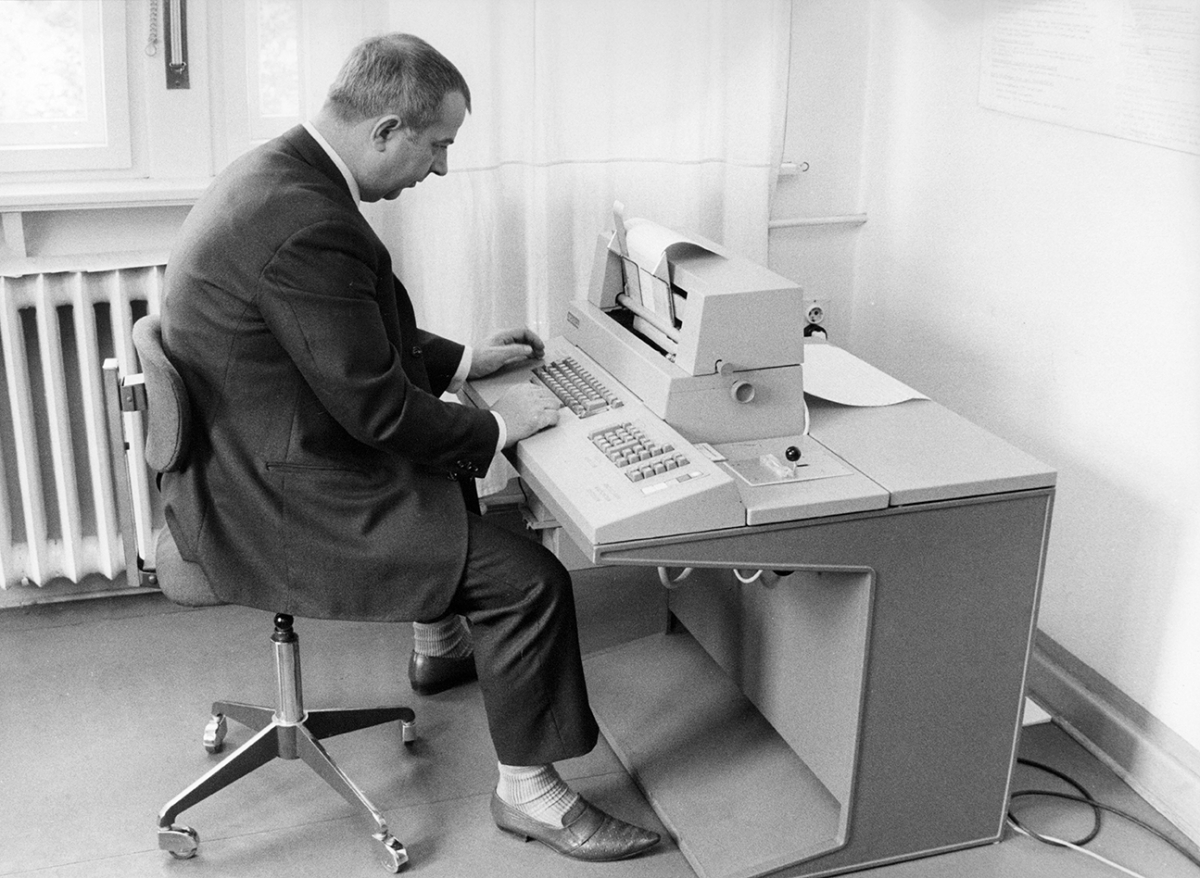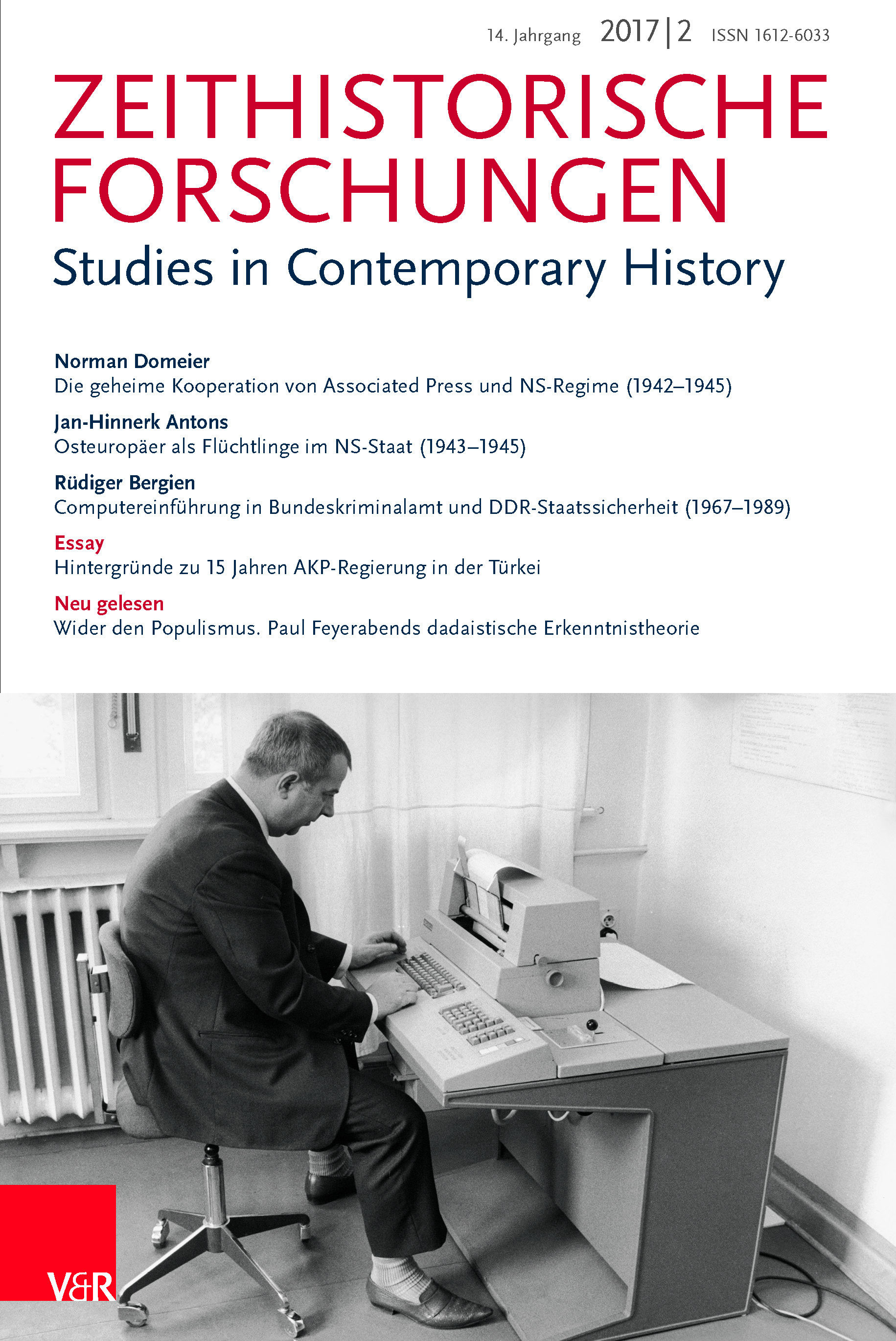Heft 2 / 2017
Aufsätze | Articles
Geheime Fotos
Die Kooperation von Associated Press und NS-Regime (1942–1945)
AbstractDer im vorliegenden Aufsatz präsentierte Quellenfund aus dem Nachlass des Auslandskorrespondenten Louis P. Lochner belegt eine geheime deutsch-amerikanische Kooperation zwischen Associated Press (AP) und dem »Büro Laux«, einer Agentur von SS und Auswärtigem Amt, während der Kriegsjahre 1942–1945. Mit Genehmigung der Roosevelt-Administration tauschten AP und Büro Laux bis zum Frühjahr 1945 täglich per Diplomatenpost Fotomaterial aus – zunächst via Lissabon, ab 1944 auch via Stockholm. Schätzungsweise 40.000 Fotos wurden so zwischen den Feinden übermittelt, während die Schlachten des Zweiten Weltkrieges geschlagen wurden und der Holocaust stattfand. In Berlin war das AP-Fotomaterial für die oberste Führung des NS-Regimes bestimmt; zudem wurde es für antiamerikanische und antisemitische Propaganda in der NS-Presse genutzt. Umgekehrt gelangten durch den Austausch Tausende Fotos aus der NS-Bildproduktion jener Jahre in die amerikanische und internationale Presse. Der Aufsatz gibt neue Einblicke in die Unternehmensgeschichte der Bild- und Nachrichtenagentur AP sowie in die Mechanismen des Auslandsjournalismus der NS-Zeit.
* * *
Secret Photos. The Cooperation between Associated Press and Nazi Germany 1942–1945This article is based on a new archival find from the papers of foreign correspondent Louis P. Lochner. It proves the existence of a secret German-American cooperation between Associated Press (AP) and the ›Bureau Laux‹, an agency of the SS and the German Foreign Office, during the war years 1942–1945. With the permission of the Roosevelt administration, AP and the Bureau Laux exchanged photos via diplomatic pouch on a daily basis until spring 1945, first via Lisbon and from 1944 via Stockholm as well. Approximately 40,000 photos were swapped in this way between the war enemies while the battles of the Second World War were fought and the Holocaust was taking place. In Berlin, the AP photos were presented daily to the highest Nazi leadership. They were then also used for anti-American and anti-Semitic propaganda in the German press. Conversely, thousands of Nazi photos received by AP New York via Lisbon and Stockholm were printed in the American and international press. This article sheds new light on both AP as a news and picture agency and on foreign reporting during the Nazi era and the Second World War.
Flucht ins »Dritte Reich«
Wie Osteuropäer Schutz im NS-Staat suchten (1943–1945)
AbstractHunderttausende Osteuropäer flohen zwischen 1943 und 1945 mit der zurückweichenden Wehrmacht gen Westen, da sie Repressionen der Sowjetmacht erwarteten. Dieser komplexe Vorgang ist in der Historiographie zu Migration und Flucht bislang wenig berücksichtigt worden. Auch das zweite hier relevante Forschungsfeld, die Geschichtsschreibung über Displaced Persons (DPs), hat vom Phänomen der nicht-deutschen Flucht aus Osteuropa kaum Notiz genommen, obwohl relevante Anteile der nicht-jüdischen DPs eben jene Flucht vollzogen hatten. Die Gründe dafür liegen möglicherweise im Unbehagen über die moralische Ambivalenz. Denn viele der Flüchtenden hatten in unterschiedlichen Formen und Ausmaßen als Unterstützer oder Mittäter des Nationalsozialismus agiert. Der Aufsatz geht nicht nur den Motiven, Bedingungen und Dimensionen dieser Fluchtbewegung nach, sondern untersucht auch, was den Umgang der NS-Institutionen mit den Flüchtlingen bestimmte. Wie wurden die zentralen Faktoren Rassismus, ökonomische und militärische Nützlichkeitserwartungen sowie politische Loyalität in der Praxis gewichtet? Exemplarische Interpretationen der Ereignisse durch ukrainische Geflüchtete bilden dabei einen Kontrast zu Sichtweisen und Quellen der NS-Administrationen.
* * *
Escaping to the ›Third Reich‹. How Eastern Europeans Sought Protection in Nazi Germany (1943–1945)From 1943 to 1945, several hundred thousand Eastern Europeans fled westwards with the retreating Wehrmacht for fear of Soviet repressions. The flight of non-Germans into the ›Third Reich‹, however, has not attracted special attention in the historiography of migration and refuge. The second contiguous field of study – historical research on Displaced Persons (DPs) – rarely touches the topic either, even though relevant groups of non-Jewish DPs in post-war Germany had come this way. The neglect of this topic may stem from its moral ambiguity, as many of the refugees had collaborated to various extents with the German occupation administrations. This article not only seeks to shed light on the motivations, the conditions and the dimensions of this migration, but also tries to show what guided the Nazi authorities in their dealings with the refugees. To what extent did they base their practical actions on the paradigms of racism, economic and military utilitarianism, and political loyalty? The perspectives and records of the Nazi administrations are contrasted with examples of how the events were interpreted in the memoirs of Ukrainian refugees.
»Big Data« als Vision
Computereinführung und Organisationswandel in BKA und Staatssicherheit (1967–1989)
AbstractSeit Mitte der 1960er-Jahre führten die Sicherheitsbehörden der hochindustrialisierten Gesellschaften die elektronische Datenverarbeitung (EDV) ein. Was aus heutiger Perspektive als Beginn eines geradlinigen Wegs in die gesteigerte staatliche Datensammlung und Überwachung erscheinen könnte, erweist sich aus der Innensicht der betroffenen Behörden der 1970er- und 1980er-Jahre als offener, mit wachsender Unsicherheit einhergehender Prozess. Für das westdeutsche Bundeskriminalamt (BKA) und das Ministerium für Staatssicherheit der DDR untersucht der Aufsatz den Zusammenhang von Computerisierung und Organisationswandel. Im Mittelpunkt des Vergleichs stehen die Konflikte, die sich aus der Frage ergaben, ob die EDV zentral oder dezentral organisiert sein sollte. Untersucht werden auch der Wandel der Personalprofile, der Informationsverarbeitung und der Wissensproduktion. Zudem wird gefragt, in welchem Maße das jeweilige politische System die EDV-Anwendungen im Sicherheitsbereich beeinflusste. Die Eigendynamik der institutionellen Expansion und des technischen Machbarkeitsdenkens war in West und Ost durchaus ähnlich.
* * *
Envisioning ›Big Data‹. Computerization and Organizational Change of the Federal Criminal Police Office and the State SecurityFrom the mid-1960s onward, the security authorities of the highly industrialized societies introduced electronic data processing (EDP). From today’s perspective this might look like the first step on the path to increased governmental data-gathering and surveillance. However, from the perspective of the authorities themselves in the 1970s and 1980s, their computerization was an ambivalent process, accompanied by growing uncertainty. The article analyses the connection between computerization and organizational change in regard to the West German Federal Criminal Police Office and the East German Ministry of State Security. The comparison focuses on the conflicts that arose from the question of whether EDP should be organized centrally or in a decentralized manner. In addition, the study examines the change of staffing profiles, of information processing and knowledge production. Finally, it considers the extent to which the particular political system influenced the computerization of the security authorities. The dynamic of institutional expansion and ›can-do‹ mindsets in terms of technological advances was in fact very similar in East and West.
Auf der Suche nach dem wahren Selbst
Feminismus, Schönheit und Kosmetikindustrie in der Bundesrepublik seit den 1970er-Jahren
AbstractFeministinnen haben seit den 1970er-Jahren im Umgang mit Schönheit und Kosmetik unterschiedliche Konzeptionen des »Selbst« entwickelt, oft sich an den Werbestrategien der Kosmetikindustrie reibend. Zeitschriften wie »Courage« und »Emma« boten dafür wichtige Foren. In der feministischen Kritik von Schönheitsidealen und Kosmetik war die Artikulation eines wahren Selbst wichtig und wurde zugleich immer wieder hinterfragt, besonders in feministischen Aneignungen des Punk. Ab den 1980er-Jahren wurde im Verständnis von Schönheit und Kosmetik zunehmend die Konzeption eines unternehmerischen Selbst deutlich, das Kosmetika situationsbedingt zur Darstellung eines flexiblen, selbstbewussten Subjekts einsetzt. Ausgehend von Topoi einer volkstümlichen Ethnologie – einem Verfahren des schnellen allgemeinen Kulturvergleichs, das sich in feministischen Analysen finden lässt, aber auch in globalen Werbekampagnen der Kosmetikindustrie – untersucht der Aufsatz, inwieweit das Verständnis von angeblichen ethnischen Unterschieden diese Entwicklungen mitgeprägt hat. Im 21. Jahrhundert leisten Menschen (auch Männer) ihre »Schönheitsarbeit« im Kontext ambivalenter Analysen von Schönheit – die als erreichbar, unterdrückend und befreiend zugleich gilt.
* * *
Searching for the Authentic Self. Feminism, Beauty and the Cosmetics Industry in the Federal Republic of Germany since the 1970sIn evaluating beauty and cosmetics, feminists have developed different concepts of the ›self‹ since the 1970s, often in friction with the advertising strategies of the cosmetics industry. Alternative magazines like Courage and Emma offered important forums for such exchanges. In feminist critiques of beauty ideals and cosmetics, the articulation of a true or authentic self was important, and yet was regularly questioned, especially in feminist appropriations of punk. From the 1980s onwards, the concept of an entrepreneurial self has become increasingly evident in discussions of beauty and cosmetics; this entrepreneurial self uses cosmetics in specific contexts to present a versatile, self-assured subject. Working with the concept of vernacular ethnology – a method of rapid general cultural comparison which can be found in feminist analyses as well as in global advertising campaigns of the cosmetics industry – the essay examines how an understanding of alleged ethnic differences has contributed to these developments. In the twenty-first century, people (men included) perform their ›beauty work‹ in the context of ambiguous conceptualizations of beauty, which is regarded as being at once attainable, oppressive and liberating.
Dressing the Black Body
Mode, Hairstyle und Schwarzsein in den USA – von den 1970er-Jahren bis zu Barack Obama
AbstractKlassische Formen des Aktivismus und der Organisierung von African Americans in der zweiten Hälfte des 20. Jahrhunderts sind schon seit geraumer Zeit Gegenstand wissenschaftlicher Studien. In der bisherigen Forschung weniger gewürdigt wurden jedoch symbolische und körperpolitische Interventionsformen. Dieser Aufsatz geht anhand der Afro-Frisur und der durch die Hip-Hop-Kultur inspirierten Mode der Frage nach, wie afroamerikanische Identität über Style Politics verhandelt wurde. Skizziert wird die Geschichte afroamerikanischer Hairstyles von den 1970er- bis zu den 2000er-Jahren. Weiterhin werden Elemente der Populärkultur wie das Blaxploitation-Kino oder die seit den 1980er-Jahren verbreitete Rap-Musik als stilbildend für afroamerikanische Modephänomene identifiziert. Die Frage der »Respektabilität«, die im Kontext rassistischer Diskurse über schwarze Frauen auftauchte, wird anhand von Michelle Obama betrachtet, die als Präsidentengattin rasch zur Stilikone aufstieg. Abschließend wird der Fall von Trayvon Martin erläutert – eines 2012 erschossenen afroamerikanischen Teenagers, durch den der Kapuzenpulli noch einmal zum Streitgegenstand und Protestsymbol wurde.
* * *
Dressing the Black Body. Fashion, Hairstyle and Blackness in the USA – from the 1970s to Barack ObamaConventional forms of African American activism and organization in the second half of the twentieth century have been the subject of academic research for quite some time, but less attention has been devoted to symbolic and body political forms of intervention. Looking at the Afro hairstyle and hip hop culture, this article explores how African American identity has been reflected through Style Politics. It outlines the history of African American hairstyles from the 1970s until the 2000s and identifies elements of popular culture such as Blaxploitation movies and rap music as constitutive of African American fashion. The question of ›respectability‹ that surfaced in the context of racist discourses about black women will be examined through the example of First Lady Michelle Obama, who rose to fame as a fashion icon. In conclusion, the article discusses the case of Trayvon Martin, an African American teenager who was killed in 2012 while wearing a hoodie, making the garment once again an object of contention and a symbol of protest.
Besprechungen | Reviews
Neu gelesen
Zitation
Redaktionsschluss
Erweiterte Suche

